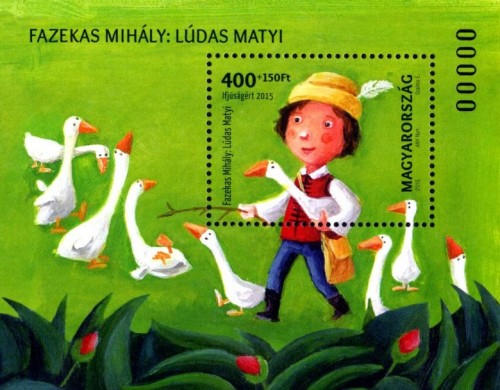
1. MAGYAR - Ifjúságért 2015 - Fazekas Mihály: Lúdas Matyi Bélyeg vásárlás >>
2. ENGLISH - For youth 2015 - Mihály Fazekas: Mattie the Goose-boy Order stamp >>
1. MAGYAR - Ifjúságért 2015 - Fazekas Mihály: Lúdas Matyi
2015-ben az ifjúsági bélyeggyűjtés támogatására a Magyar Posta feláras bélyegblokkot bocsát ki. A bélyegblokk témáját Fazekas Mihály Lúdas Matyi címűelbeszélő költeményének illusztrációja biztosítja. Az újdonságon Szalma Edit akrilfestékkel készített alkotása látható, a bélyegképen az ifjú, ludakat terelő Matyival. A felár összegét, vagyis blokkonként 150 Ft-ot a Magyar Posta az ifjúsági bélyeggyűjtés támogatására fordítja. A bélyegblokkot 40.000 példányban az ANY Biztonsági Nyomda gyártotta. Március 24-től kapható az ország nagyobb postáin, valamint a Filapostán, de megrendelhető a Magyar Posta internetes áruházából is.
A Lúdas Matyi első kiadása 1815-ben jelent meg Bécsben, a szerző tudta nélkül. Fazekas Mihály 1815. november 15-én levelet küldött a kiadónak, amelyben tudatta, hogy a Lúdas Matyit még 1804-ben írta, de miután az 1805-ben Kazinczy Ferenc tetszését nem nyerte el, nem szánta kiadásra. Ekkor átdolgozta, és második, javított kiadásként jelent meg 1817 júniusában, F. M. kezdőbetűkkel a címlapon, 8 rét egy íves füzetben négy fametszettel, rajzolt borítékkal és 36 koronáért árulták. Minden ebből származó bevételt, mint a mellé ragasztott híradás tudtul adta, a kiadó a szombathelyi és körmendi tűzkárosultak segélyezésére fordította. A harmadik kiadás 1831-ben Budán jelent meg. Ezután sok kiadást ért meg, és a ponyvára kerülve eljutott a nép közé is.A mű Lúdas Matyiról, az egyszeri libapásztorfiúról szól, aki többször is túljár a kapzsi és zsarnok földesúr, Döbrögi eszén. A költemény témáját a szerző a középkorba helyezte, de valójában saját koráról mond ítéletet. Főhőse jellegzetes népmesei figura. Igazi magyar történet: a táj magyar, az emberek magyar parasztok, Döbrögi magyar földesúr. A költő művében szívesen alkalmazza a népnyelv fordulatait, tájszavait; stílusa humoros, és tükrözi együttérzését a szegényekkel.Több alkalommal is feldolgozták. Balogh István bohózatot, Móricz Zsigmond vásári komédiát írt a mű alapján. Deésy Alfréd némafilmet forgatott. Az egyik legismertebb filmváltozat Nádasdy Kálmán és Ranódy László rendezésében, Soós Imre főszereplésével készült és 1949-ben került bemutatásra. Dargay Attila 1977-ben egész estés rajzfilmet készített, ami alapján Romhányi József szövegével 45 normál kockás, színes diafilm készült. (F.: wikipedia.org)
Forrás: Posta
2. ENGLISH - For youth 2015 - Mihály Fazekas: Mattie the Goose-boy
In 2015 Magyar Posta is issuing a stamp block with a surcharge to support youth stamp collecting. The theme of the stamp block is provided by the illustration of the epic poem based on a folk tale Mattie the Goose-boy by Mihály Fazekas. The new issue features an acrylic painting by Edit Szalma. The stamp shows Mattie the Goose-boy with his geese. Magyar Posta devotes the amount of the surcharge, that is HUF 150 for each block, to supporting youth stamp collecting. Forty thousand copies of the stamp block were produced by ANY Security Printing Company. The stamp block will be available at large post offices and Filaposta in Hungary from 24 March, but may also be purchased from Magyar Posta’s webshop.
Mattie the Goose-boy was first published in 1815 in Vienna without the author’s knowledge. Mihály Fazekas wrote a protesting letter to the publisher on 15 November 1815, in which he explained that he had refrained from publishing his work in that form after he wrote it in 1804 because it had not won the approval of his fellow writer Ferenc Kazinczy in 1805. A reworked version of the poem appeared in June 1817 as a second, improved, octavo edition bearing the author’s monograms F. M. on the title page. This edition, priced 36 crowns, included four woodcuts and had an illustrated cover. An advertisement attached to the volume announced that the proceeds from its sale would be devoted by the publisher to helping the victims of a fire in Szombathely and Körmend in western Hungary. The third edition was published in Buda in 1831. After that, the poem was published many times, including cheaper editions which reached a wider audience.
The work’s main character is a simple gooseherd, Mattie the Goose-boy, who is smart enough to trick the rich and greedy lord of the manor on a number of occasions. Although the author set the poem in the Middle Ages, he wrote a critique of his own times. Mattie is a typical folk-tale character. The story is quintessentially Hungarian with Hungarian peasants and a Hungarian lord of the manor set in a Hungarian landscape. The poem is richly endowed with folk expressions and idioms, and has a humorous style reflecting sympathy with the poor.
It has been adapted many times. István Balogh wrote a comedy and Zsigmond Móricz composed a farce based on the poem, while Alfréd Deésy made a silent film of it. One of the best known film adaptations was directed by Kálmán Nádasdy and László Ranódy, which was first screened in 1949 and starred Imre Soós in the main role. An animated feature film was made of the story by Attila Dargay in 1977 and, based on this, a 45-slide colour film strip with text by the poet József Romhányi was produced. (Source: wikipedia.org)










